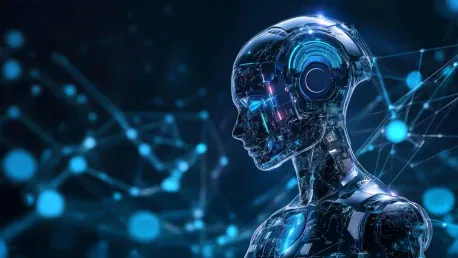The Internet of Things (IoT) market is on the brink of a transformative expansion, with its global value expected to nearly double from $959.6 billion this year to $1.8 trillion by 2028. This remarkable growth is driven by the integration of emerging technologies like 5G and artificial intelligence (AI) and the implementation of non-terrestrial network (NTN) solutions. This strong prediction by GlobalData underscores a compound annual growth rate (CAGR) of 13.5 percent and paints a vivid picture of the IoT landscape’s future.
Growth of Enterprise IoT
Private 5G Networks and Edge AI Applications
Enterprise IoT is projected to account for an impressive 72 percent share of the market by 2028, up from 70 percent in previous years. This significant growth is largely attributed to the widespread adoption of private 5G networks and the infusion of AI applications, particularly at the edge where data is processed locally. The advancement in private 5G networks allows for more secure, reliable, and high-speed connectivity, which is essential for enterprise operations. At the same time, edge AI applications enable real-time data processing and decision-making, significantly enhancing operational efficiency and productivity. These combined innovations are pivotal in sectors such as manufacturing, logistics, and healthcare, where timely data is crucial to operations. As more companies realize the benefits of these technologies, the momentum behind enterprise IoT continues to build.
Consumer IoT: Opportunities and Challenges
Despite the rapid advancement in enterprise IoT, the consumer IoT segment is expected to witness a slight decline in its market share. The consumer IoT sector, which includes smart home devices, wearables, and personal gadgets, is anticipated to capture 28 percent of the market by 2028, down from 30 percent in previous years. This modest expansion suggests there are untapped opportunities and inherent challenges within consumer IoT. The slower pace can be attributed to several factors, including variations in consumer technology adoption rates, concerns around data privacy, and the need for more seamless integration across different smart devices. While growth is more tempered in this segment, it remains a vital area of innovation and development. Companies that can address these consumer concerns and offer innovative, user-friendly solutions will likely lead the way in expanding this market further.
The AIoT Landscape
Integrating AI into IoT Devices
One of the key themes shaping the IoT market is the integration of AI into IoT devices, creating what is now known as the AIoT landscape. AIoT refers to the inclusion of AI processing capabilities within IoT gateways and sensors, significantly enhancing the automation and predictive maintenance capabilities of various operations. This fusion of technology facilitates the efficient processing of vast amounts of data generated by IoT devices, enabling faster and more accurate decision-making. For instance, in predictive maintenance, AI algorithms can analyze data from sensors to predict equipment failures before they occur, thus preventing costly downtimes and improving overall operational efficiency. The ability to process information locally, closer to where it is collected, reduces latency and enhances the speed and reliability of responses, making AIoT a game-changer across various industries.
Enhancing Automated Operations
The evolution of AIoT is not just limited to individual sensors or devices. It extends to broader digital ecosystems where multiple sensor types and cloud-based analytics play a crucial role in improving overall processing capabilities. Enhanced automated operations allow industries to monitor and manage their assets and resources more effectively. For example, automated logistics systems can streamline supply chain operations by analyzing real-time data on inventory and deliveries and optimizing routes for efficiency. Similarly, in smart agriculture, AIoT can facilitate precision farming techniques, where AI-driven insights from sensor data help optimize irrigation, fertilization, and pest control processes. As industries continue to harness the power of AIoT, this synergy promises to drive unprecedented efficiencies and capabilities, making it an integral part of the IoT ecosystem.
Non-Terrestrial Network Solutions
Expanding IoT Coverage
NTN solutions are another critical aspect of the IoT market’s rapid expansion. These solutions involve the use of low-Earth and geostationary satellites to provide coverage over vast, uninhabited or remote areas. The ability to extend IoT connectivity beyond terrestrial networks is vital for industries such as shipping, agriculture, and mining, which often operate in isolated locations. By leveraging NTN constellations, companies can achieve reliable global tracking and monitoring of their assets, ensuring continuous connectivity and data exchange no matter where operations are based. For example, in the maritime industry, satellite-based IoT can provide real-time monitoring of ships and cargo, improving safety and logistics. Similarly, in remote mining operations, NTN can facilitate the monitoring of equipment and environmental conditions, enhancing both efficiency and safety practices.
Implementing IoT in Remote Industries
The implementation of NTN solutions within IoT frameworks presents numerous opportunities, particularly as traditional wireless networks often fail in remote areas devoid of significant infrastructure. With NTN satellites, critical telemetry and tracking capabilities are ensured across sectors requiring dependable connectivity in challenging environments. This capability has broad applications, from enabling precision agriculture in extensive farmlands to ensuring workers’ safety in distant, hazardous mining locations through constant gear monitoring. Importantly, NTN capabilities not only provide coverage but also robust data links, enriching remote operations with real-time insights and analytics. This ability to maintain a constant, reliable flow of data, regardless of geographical constraints, is poised to significantly enhance operational efficiency and strategic planning across myriad industries reliant on IoT.
Tackling IoT Security Challenges
Overcoming Fragmented Standards
As the IoT market expands, one of the critical challenges it faces is ensuring secure deployments amidst fragmented standards. Standardization is crucial for the interoperability and security of IoT devices and systems. However, the diversity of devices and lack of unified standards often result in vulnerabilities and inconsistent security protocols. These discrepancies make it challenging to implement cohesive and effective security measures across different IoT ecosystems. The development and adoption of universal standards are essential to mitigate these risks. Moreover, the IoT industry must establish comprehensive guidelines and best practices to secure devices from their inception through their entire lifecycle, ensuring that security is not an afterthought but a foundational component of IoT deployment.
AI and IoT Security
AI holds promise in addressing the security challenges plaguing IoT deployments. By leveraging AI, it is possible to enhance security measures even at the device level despite the limited computing power of many IoT devices. AI-driven security solutions can offer real-time threat detection and response capabilities, identifying potential security breaches and vulnerabilities before they can be exploited. For example, machine learning algorithms can analyze patterns and behaviors within IoT networks, flagging anomalies that may indicate a security threat. These proactive measures can significantly strengthen the security posture of IoT environments. Moreover, AI can facilitate the automation of security protocols, ensuring that all devices within a network adhere to the latest security standards and practices. As IoT continues to evolve and expand, the integration of AI into security frameworks will be critical in safeguarding these interconnected ecosystems.
Conclusion
The Internet of Things (IoT) market is on the verge of a significant expansion, with its global value predicted to almost double from $959.6 billion in 2023 to an astounding $1.8 trillion by 2028. This extraordinary growth trajectory is fueled by the seamless integration of cutting-edge technologies such as 5G and artificial intelligence (AI), along with the adoption of innovative non-terrestrial network (NTN) solutions. GlobalData’s robust forecast highlights a compound annual growth rate (CAGR) of 13.5 percent, illustrating a promising future for the IoT landscape. As these advanced technologies become more prevalent, they are expected to revolutionize industries by enhancing connectivity, efficiency, and automation. The burgeoning IoT market will likely yield substantial benefits, transforming everyday life and driving economic progress. This rapid advancement signals a pivotal moment where the digital and physical worlds intersect, setting the stage for a smarter, more connected future.









